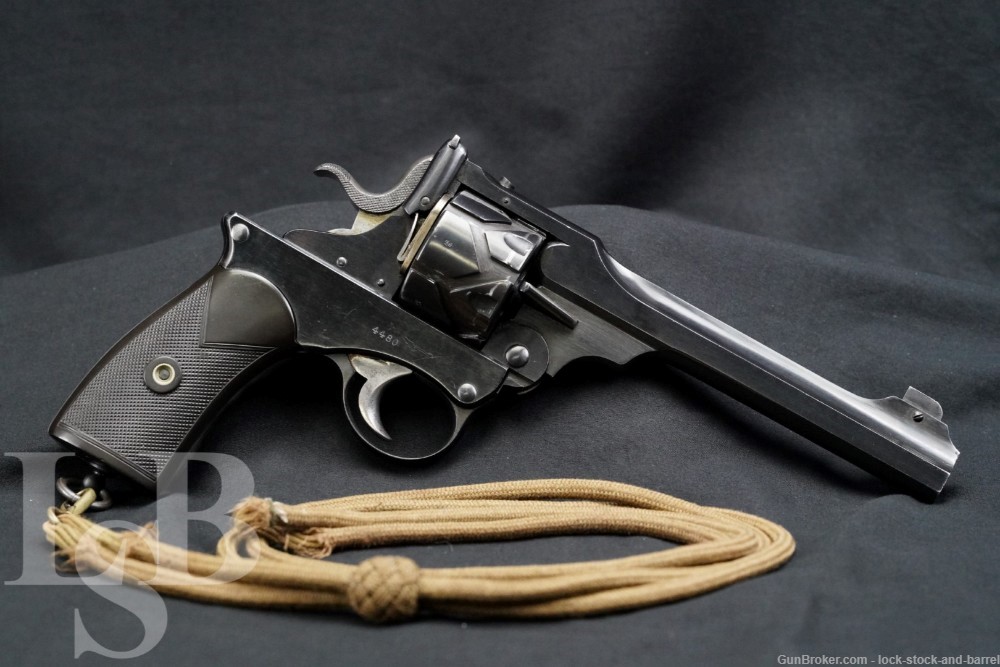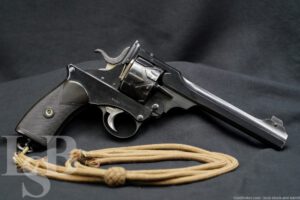
Webley Fosbery Model 1902 6” .455 Semi-Automatic Revolver 1919 C&R
SOLD FOR: $13125
LSB#: 230524SH001
Make: Webley Fosbery
Model: Model 1902 Automatic Revolver
Serial Number: 4480
Year of Manufacture: 1919 (http://www.armsresearch.co.uk/)
Caliber: .455 Mark II
Action Type: Single-Action Blowback operated Automatic Revolver
Markings: The left side of the top-strap is marked “WEBLEY-FOSBERY”. The rib is marked “WEBLEY & SCOTT LTD BIRMINGHAM & LONDON.” and has three post-1904 Birmingham proofs. The left side of the frame is marked with the Webley & Scott winged bullet logo and “.455 CORDITE” The right side of the frame is marked “4480”. The chambers on the cylinder are each marked with a commercial post-1904 Birmingham proof mark. The rear of the cylinder is marked “480”. The bottom of the cylinder retaining cam is marked “80” on the right side. The left side of the recoil mechanism is marked “4480”, the recoil lever is marked “4480” on the right side, and “4480” on the bottom left of the frame, all visible when the grips are detached.
Barrel Length: 6”
Sights / Optics: The front sight is a thin squared blade pinned to a boss at the front of the barrel. The rear sight is a “U” notch that is dovetailed in the top of the barrel latch.
Stock Configuration & Condition: The grips are two piece black checkered hard rubber. An integral lanyard ring is present on the bottom of the grip frame. The grips show light handling and storage marks. A small ding has flattened a small portion of checkering where the border “V” comes to a point. The most notable damage is on the forward most points of both the grips, the right panel has a small corner that has been removed and the left is a larger amount of material removed with a small gap present when mounted to the revolver.. There are no cracks. The grips rate in Very Good overall condition.
Type of Finish: Blued
Finish Originality: Original
Bore Condition: The bore is semi-bright, the rifling is well-defined. There is some light erosion in the grooves at the bore. In this writer’s opinion and for the age, this bore rates a 8 out of 10.
Many C&R eligible weapons have bores that will show erosion. This is not only due to age but to the fact that corrosive primers were commonly used in ammunition worldwide. For example, the U.S. used corrosive ammunition throughout WWII. The U.S. military did not begin to phase out corrosive-primed ammunition until the 1950s.
Overall Condition: This pistol retains about 65% of its metal finish. The metal shows light scratches on the right side of the frame around the serial number. The barrel shows light discoloration from oxidation near the muzzle of the revolver and on the flats of the barrel in front of the cylinder and behind on the frame. The steel cylinder plate shows stubborn grease residue on the back. The cylinder shows minor light scratches and drag lines from operation wear. The cylinder also shows discoloration from oxidation in the cylinder grooves. The grip areas show more significant finish wear on the front and back straps. The trigger and action shows operational wear. The screw heads are sharp. The markings are sharp. Overall, this pistol rates in about Very Good – Very Good Plus condition.
Mechanics: The action functions correctly, the safety functions correctly as well. We did not fire this firearm. As with all used firearms, a thorough cleaning may be necessary to meet your maintenance requirements.
Box, Paperwork & Accessories: A 35” corded lanyard with a brass clip is attached to the lanyard loop on the bottom of the grip frame. The cording is fraying on some portions of the cordage, however it is still strong.
Our Assessment: “Semi-automatic pistols were just beginning to appear when Colonel Fosbery (1832–1907) devised a revolver that cocked the hammer and rotated the cylinder by sliding the action, cylinder, and barrel assembly back on the frame. The prototype was a modified Colt Single Action Army revolver. Fosbery patented his invention August 16, 1895 and further improvements were patented in June and October 1896.
Fosbery took his design to P. Webley & Son of Birmingham. P. Webley & Son, which merged with W.C. Scott & Sons and Richard Ellis & Son in 1897 to form the Webley & Scott Revolver and Arms Co., was the primary manufacturer of service pistols for the British Army as well as producing firearms for civilian use. Webley further developed the design and the Webley-Fosbery Automatic Revolver was introduced at the matches at Bisley of July 1900.
The revolver was initially made in .455 calibre for the British service cartridge, and later in .38 ACP. While the .455 version had a standard 6-round cylinder, the .38 high velocity (.38 Colt ACP) version had eight chambers and could be loaded by a circular full-moon clip. The .38 version had a shorter cylinder, and thus shorter recoil stroke. Some were made with the short frame in .455 caliber. A variety of modifications led to the production of 6 different models, Marks I through VI.
In civilian use, the Webley-Fosbery was popular with target-shooters. Because the trigger mechanism did not rotate the cylinder, shots were smooth and consistent, permitting rapid and accurate shooting. Walter Winans, a famous contemporary target shooter, preferred the Webley-Fosbery and in 1902 he used it to place six shots in a two inch bull’s-eye at 12 paces in seven seconds. Using a Prideaux speedloader he was able to fire twelve shots into a three inch bull’s-eye in approximately 15 seconds. Recent research using a .455 short frame model in Switzerland has achieved a five-shot 8? group at 10 meters in 1.27 seconds.
The Webley-Fosbery was available in several standard configurations with barrel lengths of 7.5 inches, 6 in., and 4 in., and was also made to order. They could also be ordered with Metford (polygonal) rifling. The pistol could also be purchased with a single-shot .22 adapter for competitive target shooting; the cylinder was removed and it was inserted into the barrel.” (Wikipedia)
This is a sharp example of a very desirable firearm. The Webley Fosbery is one of the most interesting firearms ever designed in which it was a stop-gap between revolvers and a semi-automatic pistol. It has been called the answer to a question that no one asked, and was probably a decade too late. The revolver has a 6” barrel, strong rifling and a very interesting action. This revolver will only rotate its cylinder by blowback or manually manipulating the action as the revolver will cock itself and the cylinder will rotate simultaneously. The British Army rejected the idea but these were bought by British Officers before, during and after WWI. They were very popular with colonial officers for their calibre and ease of firing for the opposing clunky semi-auto pistols available at the time and the single action revolvers. The revolver has a military style corded lanyard attached that has some imperfections. These revolvers are scarce and growing more so every year. If you are interested in Webleys, revolvers, or semi-automatic pistols, don’t miss out on this revolver as you have the best of all three!
-Luke

